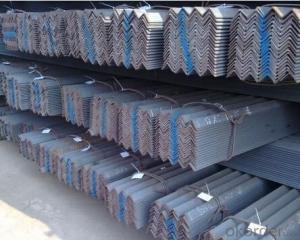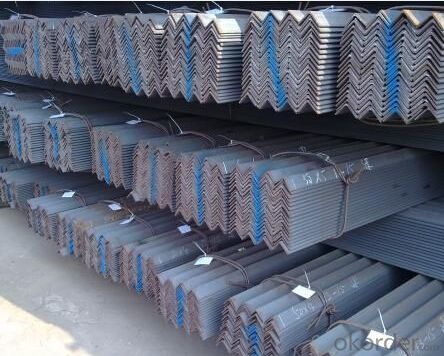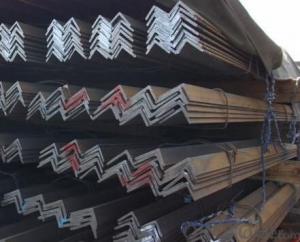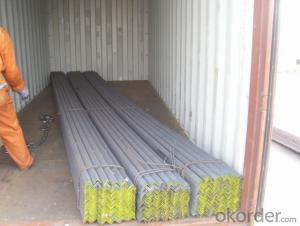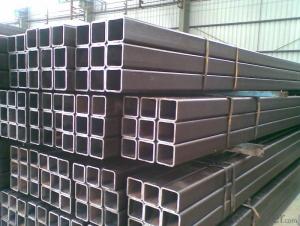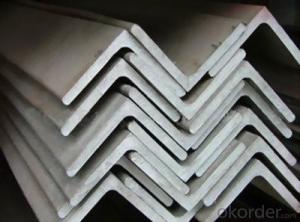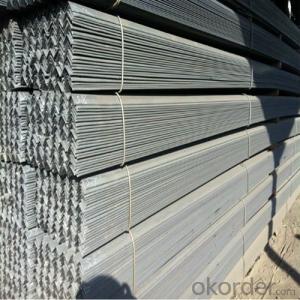Stainless Angle Steel with Standards GB,ASTM,BS,AISI,DIN,JIS
- Loading Port:
- Tianjin
- Payment Terms:
- TT or LC
- Min Order Qty:
- 20 m.t.
- Supply Capability:
- 100 m.t./month
OKorder Service Pledge
OKorder Financial Service
You Might Also Like
Product Description:
OKorder is offering Stainless Angle Steel with Standards GB,ASTM,BS,AISI,DIN,JIS at great prices with worldwide shipping. Our supplier is a world-class manufacturer of steel, with our products utilized the world over. OKorder annually supplies products to European, North American and Asian markets. We provide quotations within 24 hours of receiving an inquiry and guarantee competitive prices.
Product Applications:
Stainless Angle Steel with Standards GB,ASTM,BS,AISI,DIN,JIS are ideal for structural applications and are widely used in the construction of buildings and bridges, and the manufacturing, petrochemical, and transportation industries.
Product Advantages:
OKorder's Stainless Angle Steel with Standards GB,ASTM,BS,AISI,DIN,JIS are durable, strong, and resist corrosion.
Main Product Features:
· Premium quality
· Prompt delivery & seaworthy packing (30 days after receiving deposit)
· Corrosion resistance
· Can be recycled and reused
· Mill test certification
· Professional Service
· Competitive pricing
Product Specifications:
1.Standards:GB,ASTM,BS,AISI,DIN,JIS
2.Invoicing on theoretical weight or actual weight as customer request
3.Material: JIS G3192,SS400;SS540.
4. Payment terms:
1).100% irrevocable L/C at sight.
2).30% T/T prepaid and the balance against the copy of B/L.
3).30% T/T prepaid and the balance against L/C
5.Sizes
EQUAL ANGLES SIZES |
| ||
a(mm) | a1(mm) | thickness(mm) | length |
25 | 25 | 2.5---3.0 | 6M/12M |
30 | 30 | 2.5---4.0 | 6M/12M |
38 | 38 | 2.5 | 6M/12M |
38 | 38 | 3.0---5.0 | 6M/12M |
40 | 40 | 3.0---6.0 | 6M/12M |
50 | 50 | 3 | 6M/12M |
50 | 50 | 3.7---6.0 | 6M/9M/12M |
60 | 60 | 5.0---6.0 | 6M/9M/12M |
63 | 63 | 6.0---8.0 | 6M/9M/12M |
65 | 65 | 5.0---8.0 | 6M/9M/12M |
70 | 70 | 6.0---7.0 | 6M/9M/12M |
75 | 75 | 5.0---10.0 | 6M/9M/12M |
80 | 80 | 6.0---10.0 | 6M/9M/12M |
90 | 90 | 6.0---10.0 | 6M/9M/12M |
100 | 100 | 6.0---12.0 | 6M/9M/12M |
120 | 120 | 8.0-12.0 | 6M/9M/12M |
125 | 125 | 8.0---12.0 | 6M/9M/12M |
130 | 130 | 9.0-12.0 | 6M/9M/12M |
140 | 140 | 10.0-16.0 | 6M/9M/12M |
150 | 150 | 10---15 | 6M/9M/12M |
160 | 160 | 10---16 | 6M/9M/12M |
180 | 180 | 12---18 | 6M/9M/12M |
200 | 200 | 14---20 | 6M/9M/12M |
5. Material Specifications:
Grade | Yield Strength,N/mm² | Extension Strength N/mm² | |||
Thickness of Steel,mm | |||||
≦16 | >16-≦40 | >40-≦100 | >100 | ||
SS330 | ≧205 | ≧195 | ≧175 | ≧165 | 330-430 |
SS400 | ≧245 | ≧235 | ≧215 | ≧205 | 400-510 |
SS490 | ≧285 | ≧275 | ≧255 | ≧245 | 490-610 |
SS540 | ≧400 | ≧390 | - | - | ≧540 |
Usage & Applications JIS SS400 Angle Steel
Trusses;
Transmission towers;
Telecommunication towers;
Bracing for general structures;
Stiffeners in structural use.
Packaging & Delivery of JIS SS400 Angle Steel
1. Transportation: the goods are delivered by truck from mill to loading port, the maximum quantity can be loaded is around 40MTs by each truck. If the order quantity cannot reach the full truck loaded, the transportation cost per ton will be little higher than full load.
2. With bundles and load in 20 feet/40 feet container, or by bulk cargo, also we could do as customer's request.
3. Marks:
Color mark: There will be color marking on both end of the bundle for the cargo delivered by bulk vessel. That makes it easily to distinguish at the destination port.
Tag mark: There will be tag mark tied up on the bundles. The information usually including supplier logo and name, product name, made in China, shipping marks and other information request by the customer.
If loading by container the marking is not needed, but we will prepare it as customer request.
Production flow of JIS SS400 Angle Steel
Material prepare (billet) —heat up—rough rolling—precision rolling—cooling—packing—storage and transportation
FAQ:
Q1: Why buy Materials & Equipment from OKorder.com?
A1: All products offered byOKorder.com are carefully selected from China's most reliable manufacturing enterprises. Through its ISO certifications, OKorder.com adheres to the highest standards and a commitment to supply chain safety and customer satisfaction.
Q2: How do we guarantee the quality of our products?
A2: We have established an advanced quality management system which conducts strict quality tests at every step, from raw materials to the final product. At the same time, we provide extensive follow-up service assurances as required.
Q3: How soon can we receive the product after purchase?
A3: Within three days of placing an order, we will begin production. The specific shipping date is dependent upon international and government factors, but is typically 7 to 10 workdays.

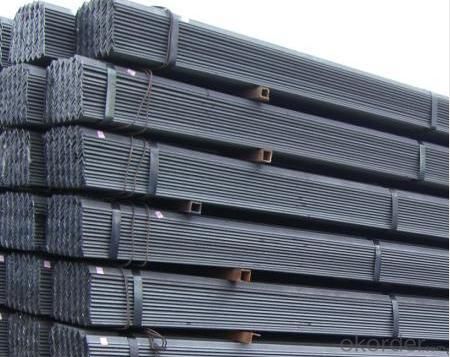
- Q: Can steel angles be used for reinforcing concrete structures?
- Indeed, concrete structures can be reinforced by employing steel angles. Steel angles, renowned for their robustness, endurance, and versatility, are frequently employed as reinforcement materials in concrete structures. By imparting supplementary strength and support to concrete, they effectively deter cracks and enhance the general structural integrity. Their employment extends across a wide range of applications including beams, columns, slabs, and walls, allowing for flexibility in both design and construction. Incorporating steel angles in the reinforcement of concrete structures augments their load-bearing capacity, resistance against bending and shearing forces, and ultimately prolongs their lifespan.
- Q: How do you protect steel angles from chemical exposure?
- To protect steel angles from chemical exposure, various methods can be employed. One effective approach is to apply a protective coating such as enamel or epoxy paint, which acts as a barrier against corrosive chemicals. Additionally, using corrosion-resistant materials such as stainless steel angles or galvanized coatings can enhance their resistance to chemical exposure. Proper storage and handling practices, ensuring minimal contact with corrosive substances, can also contribute to protecting steel angles from chemical damage.
- Q: How do steel angles perform under lateral or wind loading conditions?
- Steel angles are commonly used in construction for their ability to withstand lateral or wind loading conditions. Due to their shape and structural design, steel angles offer excellent resistance against bending and twisting forces. They distribute the applied loads efficiently, ensuring stability and minimizing any potential structural damage. Overall, steel angles are reliable and perform exceptionally well under lateral or wind loading conditions.
- Q: Can steel angles be easily modified or customized on-site?
- Yes, steel angles can be easily modified or customized on-site. Steel angles can be cut, drilled, welded, and bent to fit specific requirements. This versatility allows for easy customization and alteration of steel angles to suit various construction or fabrication needs. Additionally, on-site modifications are often necessary to ensure precise fitting and alignment during installation. With the right tools and expertise, steel angles can be modified and customized on-site without significant difficulty.
- Q: 100 x 100 x 10 equal angle steel, per meter weight?
- The angle iron can be made up of different force components according to the different structure, and can also be used as the connecting piece between the components. Widely used in a variety of architectural and engineering structures, such as beams, bridges, towers, hoisting and conveying machinery, ships, industrial furnace, reaction tower, container frame and warehouse shelves steel base.
- Q: What are the properties of steel angles?
- Steel angles, which are also referred to as angle iron or L-shaped steel, possess numerous qualities that contribute to their extensive use and versatility across various industries. 1. Strength and durability: Solid steel is used to manufacture steel angles, resulting in exceptional strength and durability. These attributes render them suitable for structural applications that demand high strength, such as constructing building frames and supports. 2. Load-bearing capability: The L-shaped design of steel angles enables them to offer excellent load-bearing capacity. They can efficiently distribute weight and provide structural support, making them ideal for the construction of bridges, towers, and other heavy-duty structures. 3. Versatility in applications: The flexibility and adaptability of steel angles allow for their usage in a wide array of applications. They can be easily cut, drilled, and welded, facilitating customization to meet specific project requirements. Commonly employed in the construction, manufacturing, and automotive industries, steel angles showcase their versatility. 4. Resistance to corrosion: Steel angles can be manufactured with corrosion-resistant coatings or can be made from stainless steel. This provides protection against rust and other environmental factors. Thus, they are suitable for outdoor applications and environments with high moisture or chemical exposure. 5. Cost-effectiveness: Comparatively, steel angles are cost-effective when compared to other structural materials like aluminum or wood. They possess a high strength-to-weight ratio, thereby minimizing the amount of material required for a given application. Consequently, steel angles are a cost-efficient choice for various construction projects. 6. Aesthetic appeal: Steel angles can also be utilized for their aesthetic appeal, adding a visually pleasing dimension to architectural designs. They can serve decorative purposes in interior design or as part of ornamental structures, providing both functionality and visual interest. In conclusion, the properties of steel angles, including their strength, load-bearing capacity, versatility, corrosion resistance, cost-effectiveness, and aesthetic appeal, make them an excellent choice for a wide range of applications in different industries.
- Q: How do steel angles contribute to the overall energy efficiency of a building?
- Steel angles contribute to the overall energy efficiency of a building in several ways. Firstly, they can be used as structural components to provide strength and support, enabling the building to withstand external forces and reduce the risk of damage or collapse. This durability reduces the need for repairs or replacements, saving energy and resources in the long run. Additionally, steel angles can be incorporated into the construction of walls, floors, and roofs to enhance insulation and thermal performance. By minimizing heat transfer and air leakage, they help maintain a more comfortable indoor environment and reduce the reliance on heating or cooling systems, thereby improving energy efficiency.
- Q: Can steel angles be used for support structures in sports arenas or stadiums?
- Sports arenas or stadiums can make use of steel angles for their support structures. The construction industry often opts for steel angles due to their strength, durability, and versatility. These angles are particularly suitable for support structures as they can handle heavy loads and offer stability. In the realm of sports arenas or stadiums, steel angles serve various purposes. They can be utilized to support the roof, create seating platforms, construct staircases, and form the framework for walls and partitions. Architects and engineers can design custom support structures that meet the specific requirements of each sports arena or stadium, thanks to the flexibility of steel angles. Moreover, steel angles can be easily fabricated and joined, which makes them ideal for constructing complex support systems. Their ability to resist bending, twisting, and compression ensures the overall stability and safety of the structure. Additionally, steel is an environmentally friendly material as it is 100% recyclable. By using steel angles for support structures, the construction industry can contribute to reducing carbon emissions and promoting a more sustainable future. In conclusion, steel angles are a dependable and efficient choice for support structures in sports arenas or stadiums. Their strength, durability, versatility, and sustainability make them an excellent option for ensuring the safety and stability of these large-scale structures.
- Q: What are the different types of steel angles connections?
- There are several different types of steel angle connections used in construction and engineering projects. Some of the most common types include: 1. Welded Connection: This is the most straightforward type of steel angle connection, where the angles are joined together using welding techniques. It provides a strong and rigid connection, but it requires skilled welders and can be time-consuming. 2. Bolted Connection: In this type of connection, the angles are connected by bolts, nuts, and washers. It allows for easier disassembly and modification, making it a popular choice for temporary structures or where future changes may be required. Bolted connections can be used with or without additional reinforcement, such as gussets or plates. 3. Riveted Connection: Riveting involves joining the angles using rivets, which are metal pins with a head on one end. Rivets are inserted into pre-drilled holes and then hammered to form a permanent connection. Although less common nowadays, riveted connections were widely used in older steel structures and bridges. 4. Clip Angle Connection: This type of connection involves using clip angles, which are small steel angles that are bolted or welded to the main angles. Clip angles provide additional support and reinforcement to the primary connection, enhancing its strength and stability. 5. Pinned Connection: Pinned connections allow for rotational movement between the angles, providing flexibility and allowing for load redistribution. They typically involve a pin or bolt passing through holes in the angles, allowing them to rotate freely. 6. Gusset Plate Connection: Gusset plates are flat steel plates that are used to connect and reinforce the angles. They are usually bolted or welded to the angles and provide additional strength and stability to the connection. The choice of steel angle connection depends on various factors such as the load-bearing requirements, structural design, ease of installation, and the need for future modifications. Each type has its advantages and disadvantages, and engineers select the most suitable connection type based on the specific project requirements.
- Q: What is the difference between galvanized and black steel angles?
- There are two types of steel angles: galvanized and black steel angles. These two types have different characteristics and uses. Galvanized steel angles are coated with a layer of zinc, providing protection against corrosion. To achieve this, the steel angles are immersed in molten zinc, allowing the zinc to bond with the steel surface. This zinc coating increases the durability and lifespan of the steel angles, making them resistant to rust and other forms of corrosion. Galvanized steel angles are commonly utilized in outdoor applications, such as construction projects, fencing, and marine environments where exposure to moisture and harsh weather conditions is a concern. On the other hand, black steel angles are not coated with any protective layer. They are made from raw steel, giving them a black appearance. Black steel angles are typically employed in indoor applications, such as structural support, framing, and general fabrication. Due to their lack of protection against corrosion, they are not suitable for outdoor use or environments with high moisture content. In conclusion, the key distinction between galvanized and black steel angles lies in their coating and resistance to corrosion. Galvanized steel angles possess a zinc coating that shields them from rust and corrosion, making them suitable for outdoor applications. Conversely, black steel angles lack any protective coating and find their primary use indoors for structural support and general fabrication purposes.
Send your message to us
Stainless Angle Steel with Standards GB,ASTM,BS,AISI,DIN,JIS
- Loading Port:
- Tianjin
- Payment Terms:
- TT or LC
- Min Order Qty:
- 20 m.t.
- Supply Capability:
- 100 m.t./month
OKorder Service Pledge
OKorder Financial Service
Similar products
Hot products
Hot Searches
Related keywords
